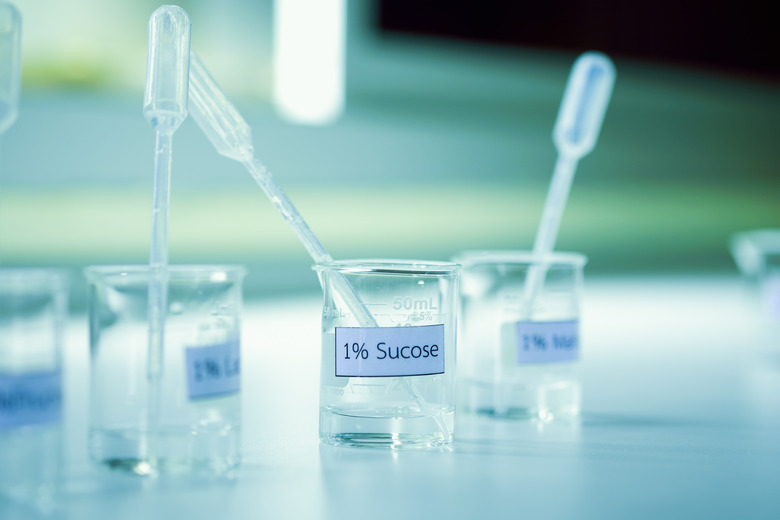What Are The Four Phases Of Complete Glucose Breakdown?
Glucose is a six-carbon sugar that can be ingested or infused directly into the body, but is more often a by-product of complex carbohydrate, protein or fat metabolism. Glucose can be used to synthesize glycogen and other storage fuels or broken down further to provide energy for metabolic processes, a series of reactions collectively termed cellular respiration. The stages of glucose breakdown can be divided into four distinct phases.
Glycolysis
Glycolysis
The initial breakdown of glucose occurs in the cell cytoplasm. This is an anaerobic reaction of cellular respiration, meaning that it does not require oxygen. Here, in a series of eight individual reactions, a six-carbon glucose molecule is metabolized using two adenosine triphosphate (ATP) molecules to form two three-carbon pyruvate molecules, two H2O (water) molecules and four ATP molecules for a net gain of two ATP molecules. ATP is a primary source of energy in human metabolism.
The Preparatory Reaction
The Preparatory Reaction
This reaction occurs in the matrix, or interior, of the mitochondria of cells. Here, the two pyruvate molecules from glycolysis are combined with two coenzyme A (CoA) molecules to produce two acetyl-CoA molecules and two carbon dioxide (CO2) molecules. This reaction occurs in a single step and, like glycolysis, is anaerobic.
The Citric Acid Cycle
The Citric Acid Cycle
Also called the tricarboxylic acid (TCA) cycle or the Krebs cycle, this series of anaerobic reactions, like the preparatory reaction, takes place in the mitochondrial matrix. Here, the two acetyl-CoA molecules from the preparatory reaction combine with a number of phosphate and nucleotide components to yield two ATP, four CO2, and a number of nucleotide intermediaries. These intermediaries are critical in the aerobic respiration that occurs in the next phase of glucose breakdown.
The Electron Transport Chain
The Electron Transport Chain
In this step, which transpires on the inner membranes of mitochondria, oxygen finally enters the picture. The transporters in this scheme are molecules of NAD and FAD, the nucleotide intermediaries noted above. In the presence of six oxygen molecules, protons are passed from NAD and FAD to other NAD and FAD molecules down the chain, allowing ATP to be extracted at various points. The net result is a gain of 34 ATP molecules.
Note that after this stage, the overall chemical reaction for glycolysis appears complete:
C6H12O6 + 6O2 –> 6CO2 + 6H2O + 38 ATP
Which Product of Glucose Breakdown Has the Most Energy?
Which Product of Glucose Breakdown Has the Most Energy?
Clearly, with two ATP from glycolysis, two from the citric acid cycle and 34 from the electron transport chain per molecule of glucose, the electron transport chain is by far the most energy-producing. This is why humans cannot be deprived of oxygen for long, and why very high-intensity (anaerobic) exercise cannot be maintained for more than a few minutes: Most physiological functions depend on a steady use of the electron transport chain.
Cite This Article
MLA
Beck, Kevin. "What Are The Four Phases Of Complete Glucose Breakdown?" sciencing.com, https://www.sciencing.com/four-phases-complete-glucose-breakdown-6195610/. 25 July 2018.
APA
Beck, Kevin. (2018, July 25). What Are The Four Phases Of Complete Glucose Breakdown?. sciencing.com. Retrieved from https://www.sciencing.com/four-phases-complete-glucose-breakdown-6195610/
Chicago
Beck, Kevin. What Are The Four Phases Of Complete Glucose Breakdown? last modified March 24, 2022. https://www.sciencing.com/four-phases-complete-glucose-breakdown-6195610/
